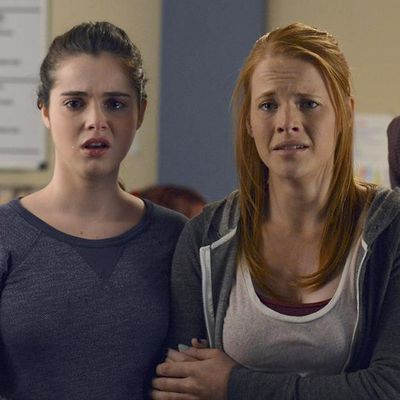
I’ve been a fan of teen shows since before I was a teen, and my enthusiasm has never really waned. This summer, the universe is rewarding me for my devotion. There are teen shows galore! And more importantly, there are terrific teen shows galore. Teens, teens, teens, as far as the eye can teen.
At the top of the heap, certainly, is ABC Family’s Monday lineup of Switched at Birth and The Fosters. SAB, about two families who discover that their teen daughters were, well, you know, is just in its third season, yet has already aired 67 episodes, which is a tremendous amount. (There are only 62 episodes of Breaking Bad, for example.) And while the show wobbled a little in the first half of its season this winter, recent weeks have found it back in fighting form, namely by allowing its characters to act as young as they are. Earlier in the season, Daphne was doing community service at a medical clinic and Bay was taking art class at a local college — effectively turning the show into a mash-up of workplace drama (Who will help the poor people get medical care?) and Felicity-lite (My art professor sees through my bullshit!). Switched at Birth, like an actual teen, shines brightest when it is truly itself. For this show, that means focusing on stories about family, identity, deaf culture, and particularly forgiveness. (SAB remains the most apologetic show on television.) Last night’s episode was a heartbreaker, harkening back to the weepy days of a good Everwood. Ensemble shows sometimes become anthology shows, with each character off in his or her own story line, and SAB does that a lot, whether it’s one mom’s new book contract or the other mom’s shady real-estate deal, and that makes the we’re-all-in-it-together stories more impactful.
That’s something SAB shares with The Fosters. Even when I don’t love every single individual story line, I love the moments where everyone comes together. The show’s second season has been just as confident and emotionally rich as the first, digging in perhaps a little more to the lingering effects on Callie and Jude of having moved between several different and abusive foster homes. Jude has been officially adopted, and Callie’s on her way there too, but permanency isn’t a panacea: Jude has developed selective mutism, and Callie’s having panic attacks. Having a real, loving family doesn’t make your problems go away, says The Fosters. It just means you don’t have to face those problems all by yourself.
Elsewhere in the teen-o-verse, MTV is in the drama game with Finding Carter, about a girl who learns she was kidnapped as a young child and the woman she thinks of as her mother is actually her abductor. The show is surprisingly self-restrained; rather than going for over-the-top soapiness, there’s an easy ordinariness to a lot of the series. Oftentimes the experience of being a teenager is that seemingly ordinary things — a pop quiz, a ride home from a party, an IM — take on extraordinary meaning and power, and Finding Carter plays with that feeling of hypersignificance while also subverting it. Yeah, Carter was kidnapped and now she’s back, but doesn’t every 16-year-old girl at some point feel like her mom is a complete stranger? Doesn’t every youngest sibling feel like the older kids get more of the attention? Dads are just like the most embarrassing, amirite?
If we’re going to talk about earnest, interesting, issue-centric teen shows, we need to talk about Degrassi. I’m still impressed by Switched at Birth’s episode count, but it does pale in comparison to Degrassi’s 354 episodes. While the show has always had its ups and downs, this season has a few solid ups: Who doesn’t love sagas of funky teen lesbians getting high and doing ballet? No one. We all love that. There’s also the super-sketchy teacher creeping on Tristan, a territory Degrassi has generally avoided. Perhaps we have Pretty Little Liars to thank for pushing teacher-student predatory sexual relationships into the foreground.
Even on shows that aren’t about teens, I find myself most interested in teen characters, like The Leftovers’ Jill. Her dad’s the sad, hot, weird sheriff, her mom’s in that tree-chopping, cigarette-smoking cult, and her brother’s in the dessert with Buddy Garrity — and she has to go to dumb-ass high school! The Leftovers’ biggest hurdle right now is giving its audience a way in, a sense of connection to the characters. Despite her irritating friends, that nexus character is Jill; she’s vulnerable but not strictly a victim, self-possessed but not fully hatched just yet.
Plenty of teen soaps are worthy of love, too, but this summer seems ruled by earnest teens, by characters and shows that want to remind you that you can and should tell your parents things and ask grown-ups for help. It’s okay to be in therapy! Plenty of people “experiment” with smoking weed — but there’s a time and a place, so please be appropriate and responsible! (And call if you need a ride.) Have sex or don’t have sex, but either way, be true to your own values and remember to be safe and respect your potential partners! Corniness sometimes creeps in, sure, but there are so many serious shows out there. Sometimes you just need a TV parent to tell you everything’s going to be okay.




